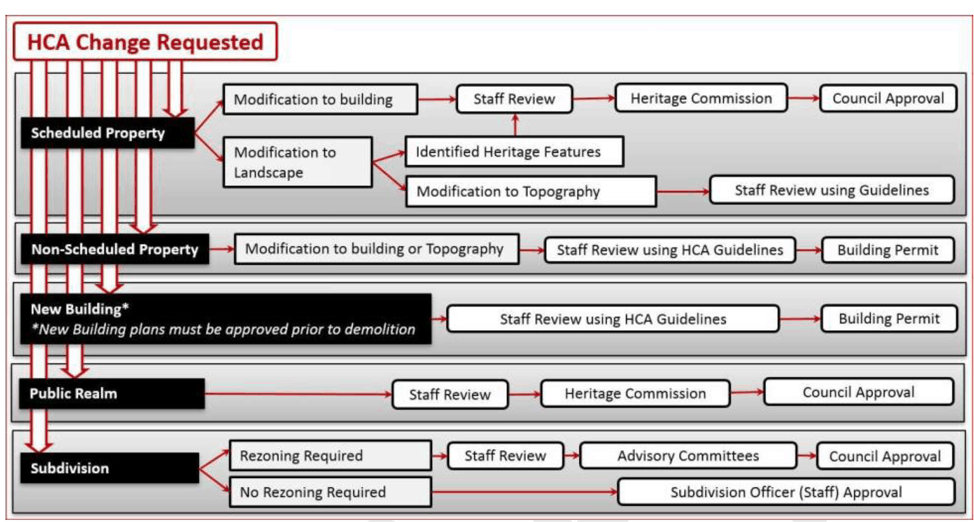- Heritage 101
- Advocacy
- Accessibility for Historic Places
- Climate & Sustainability
- Cultural Maps
- Heritage Place Conservation
- Heritage Policy & Legislation
- Homeowners
- Intangible Cultural Heritage
- Reconciliation
- Indigenous Cultural Heritage
- Setting the Bar: A Reconciliation Guide for Heritage
- 1. Heritage and Reconciliation Pledge
- 2. Acknowledging Land and People
- 3. Celebrating Days of Recognition and Commemoration
- 4. With a Commitment to Learn
- 5. Committing to Strategic Organizational Diversity
- 6. Mission-Making Room for Reconciliation
- 7. Possession, Interpretation, Repatriation and Cultural Care
- 8. Shared Decision Making
- 9. Statements of Significance and other heritage planning documents
- 10. Heritage Conservation Tools, Local Government Act
- Racism: Do Not Let the Forgetting Prevail
- Taking Action: resources for diversity and inclusion
- Webinars On-Demand
Heritage Conservation Areas: Heritage Alteration Permit
 Overview of Heritage Alteration Permits
Overview of Heritage Alteration Permits
Guidelines established with the HCA will include construction and alteration restrictions that aim to protect the integrity of the overall area and the heritage values of the individual properties. Unless an exemption is provided in the HCA, the property owner will require a Heritage Alteration Permit (HAP). If granted, the HAP will provide the property owner with the needed approvals (e.g. to bylaws, zoning, guidelines) in order to proceed with the desired changes to the protected property. As a result, the HAP offers flexibility to the local government and the property owner.
Heritage alteration permits are used most frequently for properties that are:
- Designated;
- Included on a heritage conservation area schedule;
- Protected by a heritage revitalization agreement;
- Protected by a heritage conservation covenant; or
- Archaeological sites or other sites protected under the heritage conservation act.
A heritage alteration permit may vary or supplement portions of the Local Government Act, including:
- Some of the provisions regarding rural land use bylaws;
- Land use designation;
- Permits;
- Development cost recovery; and
- Subdivision and development requirements.
Local governments may not refuse to issue a HAP as a means to prohibit the legitimate development of property, and it may not be used to vary the use or density provisions of the local government’s land use bylaw.
Heritage Conservation: A Community Guide provides the following information about utilizing a HAP:
- Local government must establish the requirements for heritage alteration permits in any heritage revitalization agreement or heritage conservation covenant. Heritage alteration permits are automatically required for properties that are designated, included on a heritage conservation area schedule, or archaeological and other sites protected under the Heritage Conservation Act.
- A property owner makes application for a heritage alteration permit that details the proposed alterations to the heritage property.
- Local government or its delegate evaluates the proposed alterations and approves or denies the issuance of a heritage alteration permit. A local government may refuse issuance of a heritage alteration permit if the proposed alterations are inconsistent with the intent of the heritage protection.
The Guide also provides the following example:
A single-family residential structure is included on a heritage conservation area schedule of an official community plan. The owner of the building makes application to the local government for a heritage alteration permit to allow for the reconstruction of a verandah on the front of the building. The director of planning, as the delegate of the local government, evaluates the application, makes suggestions for improvement of the design, finalizes the design with the applicant, and issues the permit.
(source)
The following chart, developed by Heritageworks for the District of Oak Bay, shows how applications to make various requests for changes will be reviewed and how staff will use the new HCA Guidelines.
 (source)
(source)
Following is the legislation as it is found in the Local Government Act (LGA), plus an accompanying commentary. Further details follow in other sections of this guide.
Please note, while this section quotes principal portions of the LGA, it is not intended to offer a legal interpretation of the LGA. Please refer to the complete Act for more information and seek legal advice as needed.
Introduction to the Legislation
Part 15 – Heritage Conservation
Division 6 — Heritage Alteration Permits
| 1) A local government or its delegate may issue a heritage alteration permit authorizing alterations or other actions if the authorization is required by
a) this Act or by a bylaw or order under this Act, b) a heritage revitalization agreement, or c) a covenant under section 219 of the Land Title Act.
|
A heritage alteration permit (HAP) is one of the conservation tools that is available to local governments. |
| 2) Subject to subsection (4), the heritage alteration permit may, in relation to protected heritage property or property within a heritage conservation area, vary or supplement provisions of one or more of the following:
a) a bylaw or heritage alteration permit under this Part; b) a land use permit under Part 14 [Planning and Land Use Management]; c) a land use regulation bylaw under Part 14; d) a bylaw under Division 11 [Subdivision and Development: Requirement and Other Related Matters] of Part 14; e) a bylaw under Division 19 [Development Costs Recovery] of Part 14. |
It can be used to vary or supplement specified bylaws and land use regulations. |
| 3) A permit issued under this section prevails over a bylaw or permit referred to in subsection (2) to the extent of any conflict. | If a conflict arises, the HAP will take precedence over a bylaw or permit. |
| 4) The following restrictions apply to subsection (2):
a) the use or density of use may not be varied; i) a zoning bylaw in relation to residential rental tenure as defined in section 455 may not be altered; b) a flood plain specification under section 524 (3) may not be varied; c) in relation to property within a heritage conservation area, the permit must be in accordance with the guidelines established under section 614 (2) (b) for the heritage conservation area. |
HAPs must be aligned with the heritage conservation area guidelines. HAPs cannot be used to alter residential rental tenures or flood plain specifications. |
| 5) A local government or its delegate may refuse to issue a heritage alteration permit for an action that, in the opinion of the local government or delegate, would not be consistent with the purpose of the heritage protection of the property. | The purpose of the HAP is to protect heritage properties and it should not be used when that purpose cannot be achieved. |
| 6) If the refusal to issue a heritage alteration permit prevents
a) the use of land that is allowed under the applicable zoning bylaw, or b) the development of land to the density that is allowed under the applicable zoning bylaw in respect of that permitted use, the local government or delegate must inform the applicant of the requirements or conditions under which a use or density proposed by the applicant in accordance with section 588 (2) [limits on use of this Part] would be allowed. |
When the local government’s refusal of a HAP request results in restricted land use or development (that would otherwise occur for non-heritage properties), the local government will provide methods by which the applicant’s wishes would be allowed. |
